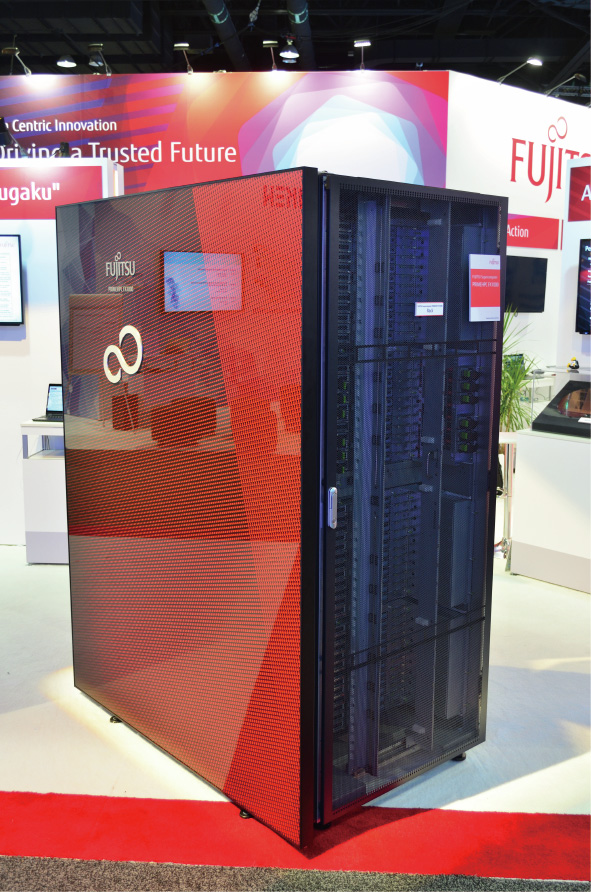As of June 2020, Japan’s Fugaku supercomputer took the crown as the most powerful system built to date, according to TOP500, the semi-annual ranking of the 500 most powerful computer systems in the world [1,2]. With a peak performance of 415.5 million billion floating-point operations per second (petaflops), Fugaku more than doubles the 200 petaflops of the former number one, the Summit supercomputer at the Oak Ridge National Laboratory in Oak Ridge, TN, USA. Highlighting how fast this field changes, Summit had only taken the top spot from China’s 93 petaflops Sunway TaihuLight supercomputer in June 2018 [2].
Bragging rights aside, the TOP500 competition is about much more than crunching the most petaflops. Advancing academic research and commercial demands continue to provide a strong impetus for pushing the envelope on how powerful these complex, enormous computers can become.
‘‘It is really about enabling types of computing that would otherwise not be possible,” said Frank Würthwein, a professor of physics at the University of California’s San Diego Supercomputer Center and executive director of the Open Science Grid, a national distributed computing partnership that facilitates access to high-throughput computing for data-intensive research in the United States.
Scientists covet the impressive abilities of these top-tier supercomputers for a wide-range of research applications. These include astrophysics and cosmology simulations that model large swathes of the universe at ever-increasing resolution, and climate change and weather modeling that can produce more accurate forecasts. Supercomputers are also used for simulating nuclear power plants and weapon explosions, in the absence of nuclear testing, and for sequencing and analyzing human genomes. They are also being used for commercial research in the aerospace, medical, and pharmaceutical industries. With its unprecedented speed, Fugaku has been sought out for cutting-edge research, including simulating the spread of the severe acute respiratory syndrome coronavirus 2 (SARS-CoV-2) coronavirus in airborne droplets [3].
Reflecting its high value, the demand for supercomputer time far outstrips availability. Supercomputers are almost continually in use, with proposals for using supercomputer time often exceeding what can be accommodated by four- or five-fold, said Justin Whitt, project director for the US Department of Energy’s Oak Ridge Leadership Computing Facility. More supercomputers and more powerful supercomputers means more potential for scientific advances. ‘‘Almost any scientist will say, ‘This is powerful, but with even more power, we could tackle these new problems, adding new physics and fidelity to the simulations.’ That opens up new avenues for science,” Whitt said.
Jointly developed by Fujitsu and the RIKEN Center for Computational Science in Kobe, Japan, Fugaku consists of more than 7 million cores, with 2.2 GHz central processing units that use 1024 GB·s-1 , and three-dimensional, stacked memory to load more data closer to the processors (Fig. 1) [4]. It is the first supercomputer capping the TOP500 list to use power- and cost-efficient, advanced reduced instruction set computer machine (‘‘ARM”) processors similar to those widely used in cellphones and other electronic devices, which reduce the number of transistors and require less cooling. In addition, rather than the graphic processing units used in most of its supercomputer peers, Fugaku employs a streamlined processing architecture known as vector computing.
《Fig. 1》

Fig. 1. One cabinet containing a set of the nearly 159 000 total nodes that coupled together power Japan’s Fugaku supercomputer. The entire machine occupies 1950 m2 , about the size of three tennis courts. Credit: Raysonho (CC BY-SA 4.0).
Fugaku’s innovative design allows it to achieve its high level of performance at an estimated cost-to-build of 1 billion USD, about five times that of Summit’s 200 million USD and on par with cost projections for the coming exascale machines [5]. Its peak power consumption—30 MW—is nearly twice that of Summit’s, and its 1950 m2 footprint adds another tennis court to Summit’s two. ‘‘These computers are large, taking up the space of a couple of tennis courts or more,” said Jack Dongarra, director of the University of Tennessee’s Innovative Computing Laboratory in Knoxville, TN, USA, coauthor of the TOP500 list, and originator of the linear system package (‘‘LINPACK”) benchmark used in the TOP500 ranking [6]. Supercomputers, including their networks and cooling systems, have always been large, but the technology changes rapidly, with miniaturization and other advances in hardware and software squeezing more power from increasingly compact systems, Dongarra said. Early supercomputers from just a couple decades ago would be considered both clunky and incredibly slow by today’s standards. ‘‘My laptop is faster than the fastest computer in 1993,” Dongarra said.
Notwithstanding delays due to the coronavirus disease 2019 pandemic, Fugaku’s reign atop the TOP500 list will likely be short, with many exascale supercomputer efforts projected to reach fruition in 2021. With speeds an order of magnitude faster than most of the current generation of petascale supercomputers, these exascale machines will blaze through more than one quintillion operations per second. The ‘‘Frontier” supercomputer at Oak Ridge, TN, USA, filling the space of ten tennis courts, ‘‘Aurora” at Argonne National Laboratory in Lemont, IL, USA, and ‘‘El Capitan” at Lawrence Livermore Laboratory in Livermore, CA, USA, are all expected to top the exascale threshold in 2021 [5,7]. China’s ‘‘Tianhe-3” was projected to reach exascale speed in late 2020, but 2021 is now more likely, Dongarra said. Besides China, which claims the most supercomputers on the TOP500 list with 226, the United States (113), and Japan (29), other major supercomputing players globally include France (19), Germany (16), the Netherlands (15), Ireland (14), Canada (13), the United Kingdom (10), and Italy (7) [1].













 京公网安备 11010502051620号
京公网安备 11010502051620号




